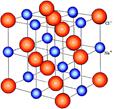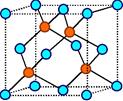
Interpretation:
Ionic crystals and the reason due to which they vary in shape needs to be explained.
Concept introduction:
Ionic bonds are formed when there is complete transfer of electrons from one atom to another. Here the atoms either lose or gain electrons so as to form negatively or positively charged ions. Due to this interaction, there is force of attraction between these ions resulting in ionic bond and hence forth ionic crystals.
Answer to Problem 64A
The ionic crystals have positive and negative ions that are arranged in geometric patten with variation in shapes due to different sizes of ions.
Explanation of Solution
Atoms convert to ions by losing electron or gaining electrons. The ions that are formed have positive or negative charges on them and hence when placed at interatomic distance will be attracted to one another. The energy involved during the formation of ionic compound is reduced by having an alternate cation and anion which minimizes the attractive forces between the oppositely charged ions.
The ions are arranged in such a way that oppositely charged ions are placed next to each other such that their total charge is zero. As the bonds are held by electrostatic force of attraction, the compounds have its ions held at lattice points and are mostly crystalline.
The structure varies as follows:




Therefore, ionic crystals consist of positive and negative ions arranged in geometric pattern. The size of ion varies and number of ions bonded varies causing variation in shape.
The ionic crystals have positive and negative ions that are arranged in geometric patten with variation in shapes due to different sizes of ions.
Chapter 7 Solutions
Chemistry: Matter and Change
Additional Science Textbook Solutions
Chemistry: A Molecular Approach
Chemistry: The Central Science (14th Edition)
Organic Chemistry (9th Edition)
CHEMISTRY-TEXT
Chemistry: Structure and Properties (2nd Edition)
Organic Chemistry (8th Edition)
 ChemistryChemistryISBN:9781305957404Author:Steven S. Zumdahl, Susan A. Zumdahl, Donald J. DeCostePublisher:Cengage Learning
ChemistryChemistryISBN:9781305957404Author:Steven S. Zumdahl, Susan A. Zumdahl, Donald J. DeCostePublisher:Cengage Learning ChemistryChemistryISBN:9781259911156Author:Raymond Chang Dr., Jason Overby ProfessorPublisher:McGraw-Hill Education
ChemistryChemistryISBN:9781259911156Author:Raymond Chang Dr., Jason Overby ProfessorPublisher:McGraw-Hill Education Principles of Instrumental AnalysisChemistryISBN:9781305577213Author:Douglas A. Skoog, F. James Holler, Stanley R. CrouchPublisher:Cengage Learning
Principles of Instrumental AnalysisChemistryISBN:9781305577213Author:Douglas A. Skoog, F. James Holler, Stanley R. CrouchPublisher:Cengage Learning Organic ChemistryChemistryISBN:9780078021558Author:Janice Gorzynski Smith Dr.Publisher:McGraw-Hill Education
Organic ChemistryChemistryISBN:9780078021558Author:Janice Gorzynski Smith Dr.Publisher:McGraw-Hill Education Chemistry: Principles and ReactionsChemistryISBN:9781305079373Author:William L. Masterton, Cecile N. HurleyPublisher:Cengage Learning
Chemistry: Principles and ReactionsChemistryISBN:9781305079373Author:William L. Masterton, Cecile N. HurleyPublisher:Cengage Learning Elementary Principles of Chemical Processes, Bind...ChemistryISBN:9781118431221Author:Richard M. Felder, Ronald W. Rousseau, Lisa G. BullardPublisher:WILEY
Elementary Principles of Chemical Processes, Bind...ChemistryISBN:9781118431221Author:Richard M. Felder, Ronald W. Rousseau, Lisa G. BullardPublisher:WILEY





